Product Images Terazosin
View Photos of Packaging, Labels & Appearance
- Image - 98351704 9ff8 4c54 a2c2 e2841873d658 01
- Image - 98351704 9ff8 4c54 a2c2 e2841873d658 02
- Image - 98351704 9ff8 4c54 a2c2 e2841873d658 03
- Image - 98351704 9ff8 4c54 a2c2 e2841873d658 04
- Image - 98351704 9ff8 4c54 a2c2 e2841873d658 05
- Image - 98351704 9ff8 4c54 a2c2 e2841873d658 06
- Image - 98351704 9ff8 4c54 a2c2 e2841873d658 07
- Image - 98351704 9ff8 4c54 a2c2 e2841873d658 08
- Image - 98351704 9ff8 4c54 a2c2 e2841873d658 09
- Image - 98351704 9ff8 4c54 a2c2 e2841873d658 10
- Image - 98351704 9ff8 4c54 a2c2 e2841873d658 11
- Image - 98351704 9ff8 4c54 a2c2 e2841873d658 12
- Terazosin Hydrochloride Capsules 2mg - A78F74CE 1C53 41EA 878E 13674DB10A67 00
Product Label Images
The following 13 images provide visual information about the product associated with Terazosin NDC 68788-8171 by Preferred Pharmaceuticals Inc., such as packaging, labeling, and the appearance of the drug itself. This resource could be helpful for medical professionals, pharmacists, and patients seeking to verify medication information and ensure they have the correct product.
Image - 98351704 9ff8 4c54 a2c2 e2841873d658 01
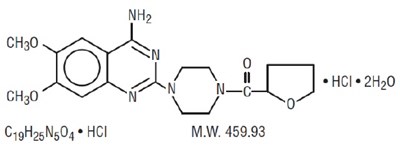
This text appears to be a chemical formula and information related to it. It indicates the components of a compound made up of chlorine, hydrogen, and oxygen, as well as the molecular weight of the compound. However, the text is not clear and some characters are not readable, making it difficult to determine the exact chemical compound.*
Image - 98351704 9ff8 4c54 a2c2 e2841873d658 02
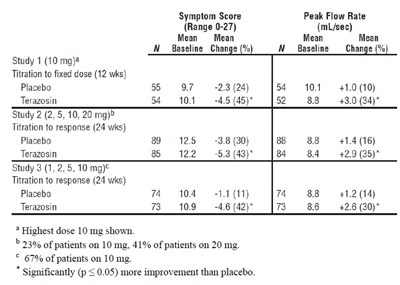
This document presents the results of three studies analyzing the impact of Terazosin on symptom score and peak flow rate, in comparison to a placebo group. In Study 1, patients were titrated to a fixed dose of 10mg for 12 weeks, with those in the Terazosin group showing a significant improvement in symptom score and peak flow rate compared to placebo. Study 2 involved titration to response of 2, 5, 10, or 20mg for 24 weeks, with patients taking Terazosin (especially those on the 20mg dose) also demonstrating significantly higher improvement. Study 3 similarly included titration to response of 1, 2, 5, or 10mg for 24 weeks, and revealed that 67% of patients on the highest dose of Terazosin exhibited a significantly greater improvement in peak flow rate than placebo.*
Image - 98351704 9ff8 4c54 a2c2 e2841873d658 03
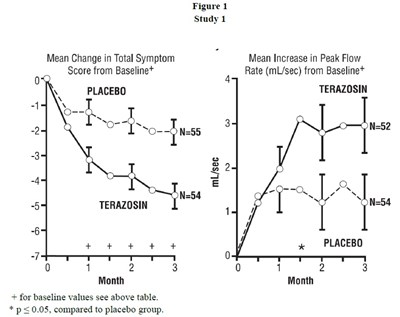
This is a study (Study 1) that compares the effects of a placebo and a drug called Terazosin on total symptom score and peak flow rate in a group of patients. The results are shown in Figure 1. The study involved 52 patients in the placebo group and 54 patients in the Terazosin group. The mean change in total symptom score and mean increase in peak flow rate were both significantly higher in the Terazosin group compared to the placebo group.*
Image - 98351704 9ff8 4c54 a2c2 e2841873d658 04

This is a figure that shows the mean change in total symptom score from baseline in a long-term, open-label, non-placebo controlled study that involved 494 individuals. The study went on for 30 months, and the graph shows the mean change from baseline at months 0, 1, 2, 3, 6, 9, 12, 15, 18, 21, 24, 27, and 30. The asterisk indicates statistical significance, with p <0.05 compared to the baseline mean of 10.7.*
Image - 98351704 9ff8 4c54 a2c2 e2841873d658 05
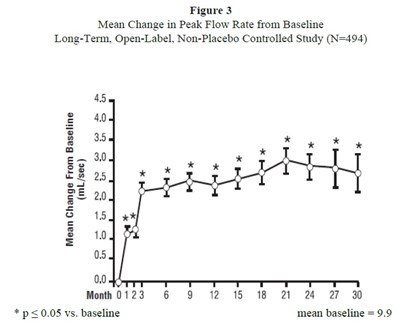
The text describes a figure (Figure 3) showing the Mean Change in Peak Flow Rate from Baseline for a Long-Term, Open-Label, Non-Placebo Controlled Study with a sample size of 494. The figure displays the mean change from baseline in mL/sec at different time points (0, 1, 2, 3, 6, 9, 12, 15, 18, 21, 24, 27, and 30 months), expressed in a graph with the y-axis labeled in mL/sec and the x-axis representing time. The figure also indicates that there is a statistical significance (p < 0.05) when comparing the mean change from baseline.*
Image - 98351704 9ff8 4c54 a2c2 e2841873d658 06
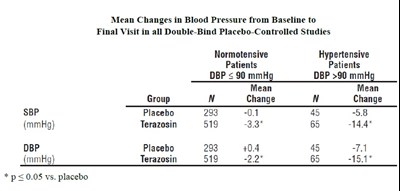
This is a table showing the mean changes in blood pressure from baseline to final visit in all double-blind placebo-controlled studies. The table lists the SBP (systolic blood pressure) and DBP (diastolic blood pressure) measurements in mmHg, and the normotensive and hypertensive groups of patients. The table shows the number of patients in each group, their mean, and the change in blood pressure for each group after taking Terazosin or Placebo. Terazosin shows a significant decrease in blood pressure compared to Placebo.*
Image - 98351704 9ff8 4c54 a2c2 e2841873d658 07
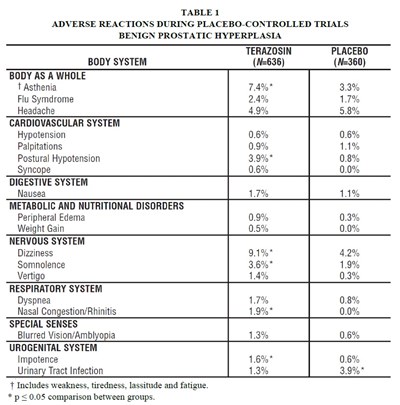
The given text provides a table of adverse reactions that occurred during placebo-controlled trials of a drug called Terazosin to treat Benign Prostatic Hyperplasia. The table lists the reactions by different body systems such as cardiovascular, digestive, nervous, and others. The reactions and their percentage occurrences in the treatment group (N=636) and the placebo group (N=360) are also provided. Some of the commonly occurring reactions for the treatment group are Asthenia, Hypotension, Postural Hypotension, Dizziness, Somnolence, Nasal Congestion/Rhinitis, and Impotence. Some of the reactions that showed a statistically significant difference between the treatment group and the placebo group are marked with '*'.*
Image - 98351704 9ff8 4c54 a2c2 e2841873d658 08
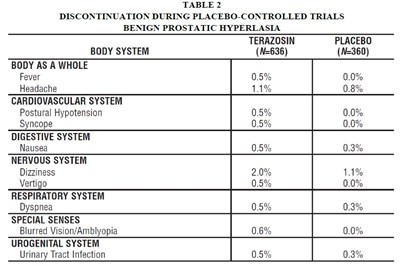
This is a table showing the percentage of discontinuation during placebo-controlled trials for Benign Prostatic Hyperplasia. The trials compared the effects of a drug called Terazosin against placebo in different body systems. The table lists the percentage of patients who discontinued the trials due to adverse effects such as headache, dizziness, blurred vision, and urinary tract infections.*
Image - 98351704 9ff8 4c54 a2c2 e2841873d658 09
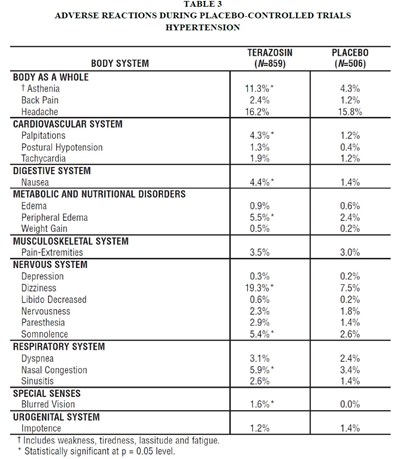
This is a table showing the adverse reactions during placebo-controlled trials of terazosin. The table shows the percentage of participants who experienced adverse reactions within different body systems, including body as a whole, cardiovascular system, digestive system, metabolic and nutritional disorders, musculoskeletal system, nervous system, respiratory system, special senses, and urogenital system. The adverse reactions that were statistically significant at the level of p = 0.05 are marked with an asterisk. Adverse reactions reported include asthenia, back pain, headache, palpitations, postural hypotension, tachycardia, nausea, edema, peripheral edema, weight gain, pain in extremities, depression, dizziness, decreased libido, nervousness, paresthesia, somnolence, dyspnea, nasal congestion, sinusitis, blurred vision, and impotence.*
Image - 98351704 9ff8 4c54 a2c2 e2841873d658 10

This is a table that shows the percentage of patients who discontinued a placebo-controlled trial for hypertension treatment using the drug Terazosin compared with a placebo. It shows the percentage of patients who discontinued due to adverse reactions in various body systems, including the body's general well-being, cardiovascular system, digestive system, metabolic and nutritional disorders, nervous system, respiratory system, and special senses. The adverse effects listed in the table include headaches, palpitations, postural hypotension, syncope, tachycardia, nausea, peripheral edema, dizziness, paresthesia, somnolence, dyspnea, nasal congestion, and blurred vision.*
Terazosin Hydrochloride Capsules 2mg - A78F74CE 1C53 41EA 878E 13674DB10A67 00
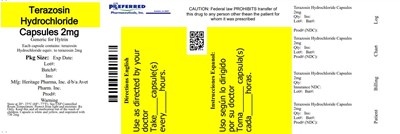
Terazosin Hydrochloride Capsules 2mg by Heritage Pharma, Inc. d/b/a Avet Pharm. I is a prescription medication containing terazosin Hydrochloride equiv. to terazosin 2mg per capsule. This medication is used to treat high blood pressure (hypertension) and symptoms of benign prostatic hyperplasia (BPH). The capsules come in a white and yellow color and are imprinted with Bsp conod. It is recommended to use as directed by a physician. This product should not be given to anyone other than the person for whom it was prescribed. Exp date, lot number, batch number, and insurance NDC are mentioned on the packaging.*
* The product label images have been analyzed using a combination of traditional computing and machine learning techniques. It should be noted that the descriptions provided may not be entirely accurate as they are experimental in nature. Use the information in this page at your own discretion and risk.

